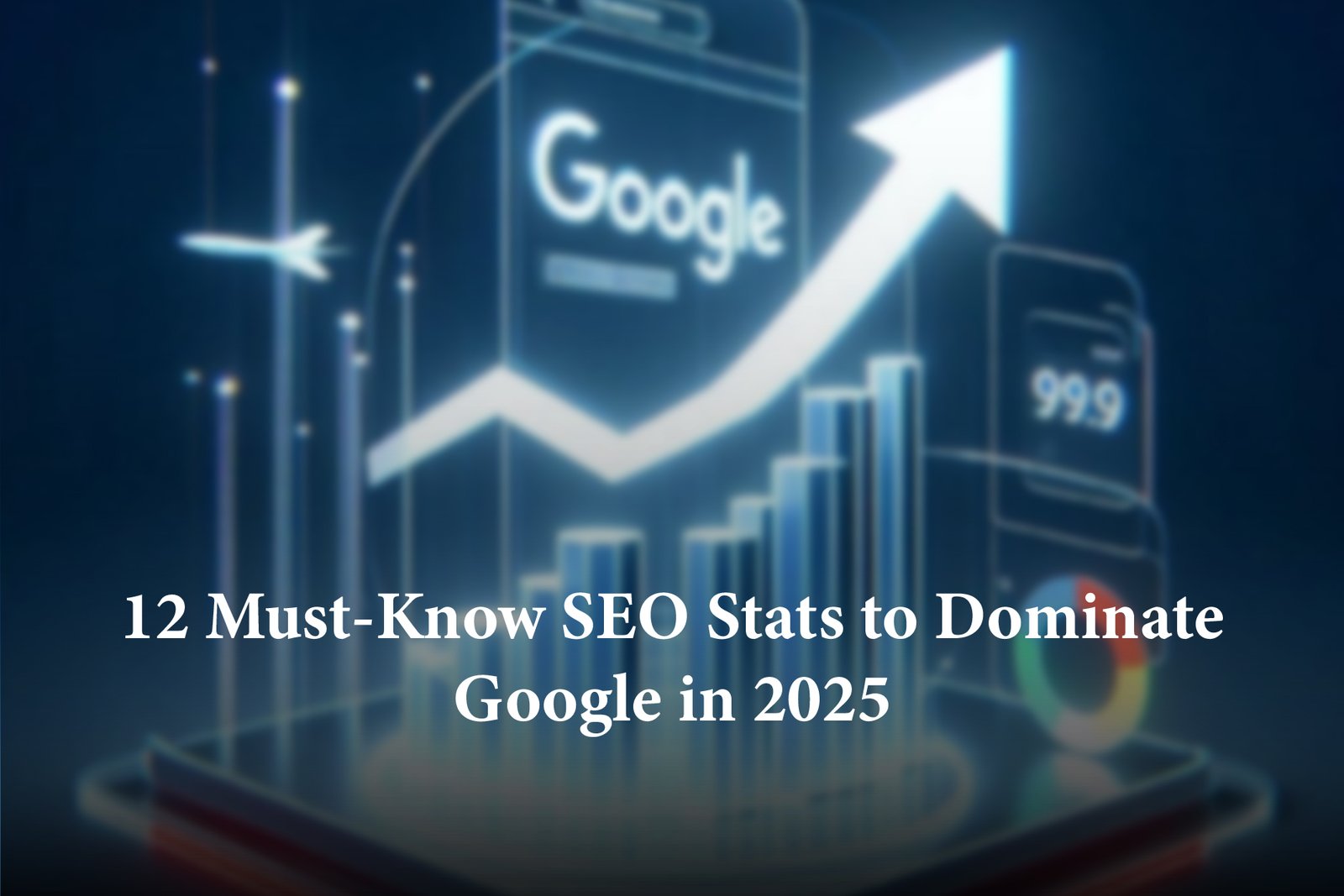Sometimes SEO feels like you are constantly going after a target, and when you think you get the algorithm right, Google changes it, or user behaviour changes, and all that worked last year is gone in vain. This is where the whole importance of keeping your SEO strategy backed by data can change the game. After all, numbers don’t lie, and in 2025, they are, of course, very clear about the direction for SEO attention.
No matter if you are a blogger who is trying to grow an audience, an e-commerce brand wanting conversions, or an agency managing tons of clients, knowing the right stats is important. Rather than basing your actions on opinions on what might work, you will be able to direct your efforts using hard evidence.
So, here are 12 must-know SEO Statistics that are not just random trivia; these statistics in SEO are useful, powerful, and this year they will guarantee you an edge over Google.
1. Google Still Owns Search with 91.5% Market Share
When people say “search engine,” most of us think of Google.” And the numbers back it up: as of 2025, Google controls 91.5% of the global search engine market. That means almost every strategy we create is (and should be) geared toward Google’s ranking systems.
Sure, Bing and DuckDuckGo exist, and they’ve even seen small bumps thanks to AI integrations, but realistically, the traffic prize is still on Google. So if you’re spending energy optimising elsewhere without first nailing Google, you’re leaving huge traffic potential on the table.
Takeaway: Prioritise Google optimisation above all else. Schema markup, Core Web Vitals, mobile-first indexing, all of it starts here.
2. Ranking #1 Means a 27.6% Click-Through Rate
Here’s a jaw-dropper: the first organic result on Google gets nearly 28% of all clicks. By the time you hit position #10, you’re scraping by with less than 3%.
This stat is a reality check for anyone stuck on page two (or worse). Visibility is everything, but visibility at the top is what drives meaningful traffic. The curve is steep; it’s not enough to be “on the first page.” You want that pole position.
Takeaway: Aim for #1 or #2 rankings by creating the most comprehensive, trustworthy resource on your topic. Use tools like SurferSEO or Clearscope to analyse competitors and close content gaps.
3. SEO Converts 8.5× Better Than Outbound Marketing
Did you know SEO leads have a 14.6% close rate, while outbound efforts (like cold emailing or print ads) hover around 1.7%? That’s an 8.5× difference.
The reason is simple: people coming from search are already warm. They’re typing queries into Google because they want something. If you’re the one providing that solution, conversion feels natural.
Takeaway: Invest in inbound SEO instead of throwing more money at outbound ads. Long term, SEO gives compounding ROI that ads rarely match.
4. The SEO Market Will Hit $143.9 Billion by 2030
The SEO industry was worth $82.3 billion in 2023, and projections show it ballooning to $143.9 billion by 2030. That’s not a bubble; it’s growth driven by businesses realising how much organic visibility impacts revenue.
Interestingly, the mobile SEO segment is growing the fastest, at around 10% CAGR, showing just how much “search on the go” is shaping strategy.
Takeaway: If you’re in digital marketing, SEO isn’t a nice-to-have; it’s a career moat. Specialising in mobile SEO and AI-driven tactics can put you ahead of competitors.
5. Mobile Accounts for 63% of All Traffic
The fact that over 92% of users access the internet on mobiles and that 63.3% of total traffic on the web is through such devices makes it quite heavy. Google’s mobile-first indexing states that a site is evaluated with regard to a mobile experience as opposed to that of a desktop.
So just when your site loads slowly, has awkward navigation, or makes people pinch and zoom, you’re losing traffic and rankings.
Takeaway: Make sure to test your site with Google’s Mobile Friendly Test and PageSpeed Insights, optimize images, use responsive design, and consider mobile-first layouts.
6. Long-Form Content Gets 3× More Traffic
Short, snappy posts are fine for news, not for SEO dominance; however, long articles of over 3,000 words blow shorter posts out of the water, gaining three times more traffic, four times more shares, and hence 3.5 times additional backlinks.
Why? It is because Google loves depth. In those long forms, you compose subtopics, respond to FAQs, and rank naturally for dozens (sometimes hundreds) of keywords.
Takeaway: Don’t merely write blog posts, but create “content hubs,” which are intended to be the comprehensive guide to the topic to which a subject would be focused. 3000-5000 words, but not as a giant wall of text, for instance, organized in subheadings and visuals.
7. Backlinks Still Carry 3.8× More Weight
Surely, backups stay as a strong signal, no matter how much anything in SEO may change. The average page ranked first in SERP statistics results received 3.8× as many backlinks as the pages ranked lower.
But hold on! Not all backlinks are created equal. Relevance and authority mean a lot more than number; a few links from these six or so high-authority, niche-relevant sites will crush the hundreds.
Takeaway: Focus on link-building strategies like guest posting, digital PR, and creating linkable assets (e.g., infographics, original studies).
8. Rich Snippets Win 58% of Clicks
Search results aren’t just about “10 blue links” anymore; they’re all about feature snippets, FAQs, and knowledge panels now. And here’s the stat: 58% of clicks go for rich results compared to only 41% for standard listings.
That being said, structured data and concise, answer-friendly content may allow you to challenge your competition, even while you are not ranking #1 organically.
Takeaway: Implement schema markup in popular terms like FAQ, review, and article. Structure content with bullet points and short paragraphs, and make them easily digestible by both AI and Google.
9. Answer Engine Optimisation Could Cut Traffic by 40%
With AI-driven search (think Google’s Search Generative Experience), 41% of SEOs are already optimising for AI answers. Why? Because studies suggest AEO could cause a 20–40% drop in traditional organic clicks for those who ignore it.
Instead of showing 10 links, Google may just give users an AI-generated answer. If your site isn’t referenced in those answers, your visibility could shrink fast.
Takeaway: Optimise for AEO. Provide concise answers, use structured data, and ensure your content is trustworthy enough to be cited by AI models.
10. Generative SEO Is Becoming a Must
Generative Engine Optimisation (GEO) is the new kid on the block. Unlike classic SEO, GEO focuses on formatting content so AI systems can understand and reuse it. By 2025, it’s no longer optional; it’s how you get visibility inside AI-powered search.
Takeaway: Break up content into digestible, well-labelled sections. Summarise complex topics in plain English. Think about how AI would “quote” your content in an answer.
11. Local Search = 46% of Google Queries
Almost half of all Google searches (46%) are looking for local info. And when users see a “map pack,” 42% of clicks go straight to those results.
For brick-and-mortar businesses, this is gold. A well-optimised Google Business Profile and local SEO can literally drive foot traffic overnight.
Takeaway: Keep your Google Business Profile updated. Encourage reviews, post updates, and optimise your site for local keywords like “near me.”
12. AI in SEO: 86% of Marketers Are Already Using It
AI isn’t a “future thing”, it’s here. As of 2025:
- 86% of SEO pros use AI in their workflow
- 75% use it for keyword research and meta descriptions
- 65% report better SEO results from AI tools
35% use AI for full content planning
Whether you’re generating outlines, clustering keywords, or drafting content briefs, AI is becoming standard practice.
Takeaway: Start small. You can utilize AI to speed up research as well as content ideation, but pair it with human editing to keep things authentic and high-quality.
Wrapping It Up
The message is clear: the importance of SEO in 2025 is more competitive, more AI-driven, and more user-focused than ever. If you want to dominate Google this year:
- Focus on long-form, mobile-first content
- Build quality backlinks
Embrace AI and AEO/GEO strategies. - Don’t ignore local optimisation.
The seo statistics 2025 prove it: SEO isn’t dead. It’s evolving. And the marketers who embrace these shifts early are the ones who will collect the biggest rewards.
Frequently Asked Questions (FAQs)
What is the SEO strategy for 2025?
What makes winning SEO in 2025 is balance, being flexible about the search engine-and AI-driven changes while sticking to tried and tested fundamentals. Success comes from creating helpful, relevant content; adopting new features like AI-search results; and optimising technically and combining innovation with the end goal, which has always been to connect the user with the very best answers.
Is SEO in demand in 2025?
Indeed, in the year 2025, SEO is still in great demand. It continues to bring the kind of traffic that turns into revenue. The difference today is that brands can no longer rely solely on SEO; they need to fuse it with newer channels and tactics. SEO is still relevant, but real success requires adaptation. Plus, as 2025 approaches, trends like AI, mobile, and local ones push companies to revisit and refine their strategies or partner with an SEO services Toronto company to level the search results playing field.
What are the top SEO statistics?
Some of the top key statistics on SEO for 2025 include 53% of website traffic originating via search engines, half of all searches comprising at least four words, and 40% of marketers claim their biggest challenge is algorithm changes. Also, when no featured snippet appears, 26% of clicks go to the first result.
What are the 4 pillars of SEO?
The four pillars are:
- Technical SEO
- On-page SEO
- Content
- Off-page SEO










